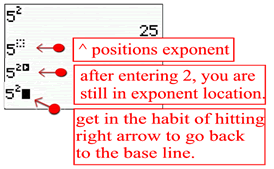| 1. |
Do not confuse the subtraction key with the negation key. |
| |
|
|

When you look at the subtraction symbol on the
screen,
it will appear
to be a tiny bit wider and
a tiny bit lower
set than
the negation symbol.
|
|
|
|
|
| 2. |
Several ways to square a value (or raise to any power.) |
| |
Square Key
Shortcut key to raise to a power of 2: (square), type the value and hit the "Square Key".
To raise to any power: type value, hit the caret (^) key, which is to the left of the "Square Key", and enter the desired power.
 You will REMAIN up in the exponent position until you hit right arrow to return to the base line. You will REMAIN up in the exponent position until you hit right arrow to return to the base line. |
 |
To raise to any power: access Template Chart  , ,  , insert value and power. , insert value and power.
 You will REMAIN up in the exponent position until you hit the right arrow to return to the base line. You will REMAIN up in the exponent position until you hit the right arrow to return to the base line.
Get in the habit of moving back to the base line from an exponent. |
|
|
|
| 3. |
Several ways to use square root (or roots to higher index). |
|
|
|
|
| 4. |
Working with parentheses. |
| |
|
|


![]()